OR/13/031 Results and discussion: Difference between revisions
| Line 74: | Line 74: | ||
Loss on ignition varied between 3.18 and 12.06% in the homogenised cores taken from the six water bodies. Figure 13 shows that there was a general tendency for LOI to increase as distance from the head waters increased. This could be expected based on the assumption that because of slowing water currents the sediment may become slightly finer as more silt and clay settle, these being the particles that organic matter will preferentially bind to. However, the particle size distributions down the river channel previously described would suggest that no consistent fining of sediment particles was found downstream, and that particle size alone may not control organic matter concentration. This was confirmed by the lack of correlation between % clay and LOI (Figure 14a). Included in the clay size fraction will be a range of minerals such as (i) sub-micron oxides, (ii) sub-micron quartz and (iii) sub micron carbonate that do not contribute significant binding surfaces for organic matter. Rawlins (2011)<ref name="Rawlins 2011">Rawlins, B G. 2011. Controls on the phosphorus content of fine stream bed sediments in agricultural headwater catchments at the loandscape-scale. Agriculture, Ecosystems and Environment, 144, 352–363.</ref> found that surface area was a better predictor than particle size for organic matter in sediments and this is largely controlled by the type and amount of clay minerals present. Further investigation by plotting organic matter against aluminium, a major component of clay, shows a positive correlation with organic matter (Figure 14b) suggesting that organic matter in the sediments is likely linked to clay content. A reasonable correlation is also found with titanium (Figure 14c) that is also a significant component of clay sized material. | Loss on ignition varied between 3.18 and 12.06% in the homogenised cores taken from the six water bodies. Figure 13 shows that there was a general tendency for LOI to increase as distance from the head waters increased. This could be expected based on the assumption that because of slowing water currents the sediment may become slightly finer as more silt and clay settle, these being the particles that organic matter will preferentially bind to. However, the particle size distributions down the river channel previously described would suggest that no consistent fining of sediment particles was found downstream, and that particle size alone may not control organic matter concentration. This was confirmed by the lack of correlation between % clay and LOI (Figure 14a). Included in the clay size fraction will be a range of minerals such as (i) sub-micron oxides, (ii) sub-micron quartz and (iii) sub micron carbonate that do not contribute significant binding surfaces for organic matter. Rawlins (2011)<ref name="Rawlins 2011">Rawlins, B G. 2011. Controls on the phosphorus content of fine stream bed sediments in agricultural headwater catchments at the loandscape-scale. Agriculture, Ecosystems and Environment, 144, 352–363.</ref> found that surface area was a better predictor than particle size for organic matter in sediments and this is largely controlled by the type and amount of clay minerals present. Further investigation by plotting organic matter against aluminium, a major component of clay, shows a positive correlation with organic matter (Figure 14b) suggesting that organic matter in the sediments is likely linked to clay content. A reasonable correlation is also found with titanium (Figure 14c) that is also a significant component of clay sized material. | ||
[[Image:OR13031fig13.jpg|thumb|center| | [[Image:OR13031fig13.jpg|thumb|center|600px| '''Figure 13''' Changes in organic matter as determined by loss on ignition (%) for the homogenised cores collected from the six water bodies of the River Nene. Water body 1 (cores 1–6), water body 2 (Cores 7–12), water body 3 (cores 13–18), water body 4 (cores 19–24), water body 5 (cores 25–30) and water body 6 (cores 31–36). ]] | ||
[[Image:OR13031fig14.jpg|thumb|center|400px| '''Figure 14''' Relationship between organic matter content with (a) clay, (b) total Al and (c) total Ti. ]] | [[Image:OR13031fig14.jpg|thumb|center|400px| '''Figure 14''' Relationship between organic matter content with (a) clay, (b) total Al and (c) total Ti. ]] | ||
Revision as of 09:17, 19 October 2021
| Tye, A M, Hurst, M D, and Barkwith, A K A P. 2013. Nene phosphate in sediment investigation — Environment Agency project ref: 30258. (Water Framework Directive). British Geological Survey Internal Report, OR/13/031. |
 |
Sediment distribution and depth in the River Nene
At each sampling site the sediment was probed to allow the calculation of sediment volume (Plate 2).
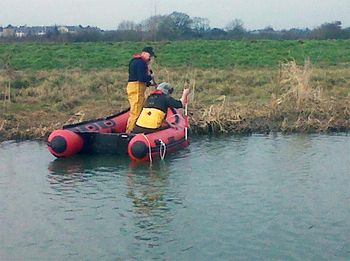
This probing allowed the mass of TP and PO4-P to be calculated for each water body. Figure 10 shows generalised patterns of sediment distribution, found in each water body as determined by probing. It is not clear to what extent this is due to the high flows in the winter period of 2012/13 which may have eroded and transported much of the channel sediment. Sediment patterns were found to be highly heterogeneous with the absence of sediment deposits being very common in much of the river. Sediment was generally found where the water currents were slowest. Figure 11 reports the average depth ±1 Standard deviation (SD) for the sediment found in each water body. Below are descriptions of the sediment characteristics for each water body.
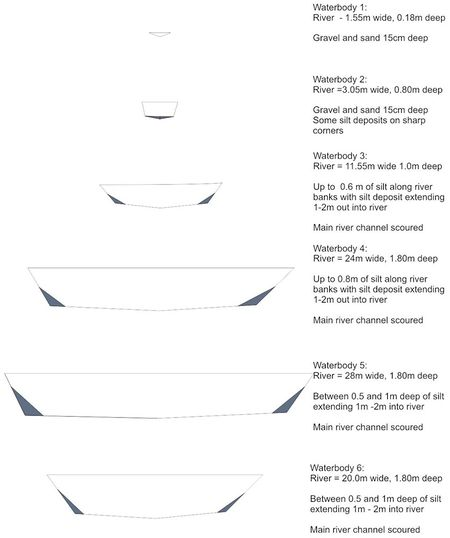

Water body 1
Water body 1 was sampled on the 7th and 8th January. Steam flow was fast throughout the sampling period at 0.4 m s-1 at site 1 of this water body. Sediment consisted at most of the sampling sites as a mixture of gravel and sand (mostly gravel) although slight build ups of coarse silt were found in areas of slower flow such as site 2 where CoreD was taken.
Water body 2
Water body 2 was sampled on the 9th and 10th January. Site 6 was not sampled during this initial sampling period as the stream was too deep for wading as a result of the high flow. Sediment consisted at most of the sampling sites as a mixture of gravel and sand (mostly gravel). CoreD (Site 1) was taken on one of the few bends in this stretch of water.
Water body 3
Water body 3 was sampled between 20th and 21st February. Sites 1 & 2 were similar in nature to the previous water body, consisting largely of a gravel and sand lag. By site 3, there was a change in the nature of the sediment as it became deeper and more silt and clay based rather than the gravel and sand previously found. Deposition of sediment also increased and was found to be 1 m+ (Site 3) close to the river bank. These sediment deposits extended up to 1 m from the bank with no sediment in the central channel. At sites 4–6 the depth and nature of sediment was variable and appeared to be dependent on position within the channel and the speed of the river.
Water body 4
Water body 4 was sampled on the 26th and 27th Feb. Again the depth and nature of sediment was highly variable and appeared to be dependent on position within the channel and the speed of the river. Site 1 was taken just after a sluice/lock in a position of slower water. Around the gravel pits there was very little sediment present anywhere in the main river channel due to scouring. The sample from site 2 was taken where the river widens and therefore current slows, whereas Site 3 was taken in a smaller backwater channel where 45 cm sediment was found. Again this was a result of no sediment being found in the main channel of the river at this point. Sites 4, 5, and 6 were again taken in the slower waters of the rivers found in inlets along the channel and before locks as the main river channel was heavily scoured. In particular, the river channel close to sand and gravel extractions were found to be highly scoured such as after White Mills Lock (Site 6).
Water body 5
At sites 1, 2, 3 and 4 sediment was generally taken in slack waters as a result of scouring of the main channel. The sampling of site 4 was moved upstream because of the lack of sediment. In the area of the river where sites 4, 5, and 6 were originally to be sampled the sediment was generally found in slack water along the channel edges as a result of the main river channel being heavily scoured. This was especially so around the sand & gravel pits near Ringstead where the water had a depth of 2+ m no sediment was found in the channel. The majority of river banks in this section appeared to be mechanically made (e.g. from dredging) but the observation from the owner of the Willy Watts marina and supporting evidence from the Environment Agency suggested that this was a result of the high stream flows removing a lot of vegetation (and probably the sediment along with it). Where sediment was found it was in areas of slack water with plants and extended about a meter into river before dropping off sharply.
Water body 6
Water Body 6 was characterised by extensive scouring of the channel of the main river channel with sediment at all sites being found in the slack and back waters where it generally extended between 1 and 2 m from the river bank edge.
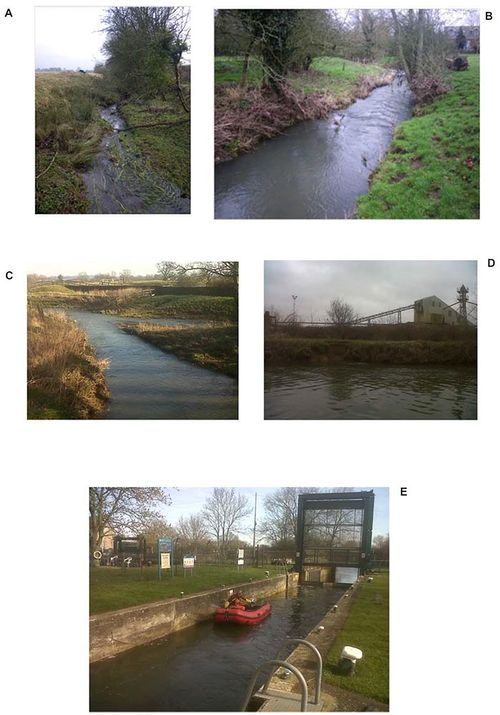
Use of probing data in calculations of P sediment volume
A major objective of this research was to calculate first order estimates of the TP and extractable P in the sediments of each water body. Thus, calculation of sediment volume in each water body is required. The section called Sediment distribution and depth in the River Nene demonstrated that there was considerable heterogeneity in the distribution of sediment deposition. The justifications used in calculating first order estimates of sediment volume are given in Table 4.
| Water body number | Description | For calculations |
| 1 | Largely gravel and sand however <2 mm fraction probably only amounts to 5 cm depth in gravel lag. | Use 5 cm <2 mm in calculations. Use mean measured depth of sediment and use channel width measured at Site 1. |
| 2 | Largely gravel and sand however <2 mm fraction probably only amounts to 5 cm depth in gravel lag. | Use 5 cm <2 mm in calculations. Use mean measured depth of sediment and use channel width measured at Site 2. |
| 3, 4, 5, 6 | Sediment largely found in slack water/plants along side channel. However, not both sides. Sediment extends out between 1 and 2 m. | Use sediment width of 1.5 m. Use mean sediment depth measured for water body. Assume distance covered by sediment is 1/32 of the distance of the two river banks. |
Bulk density of sediment
Bulk density data is required to convert the estimated volume of sediment into a mass measurement that we can use to calculate TP and PO4-P loadings. From the core measurements (an average value of 0.5g cm-3 was obtained which is similar to the value used by Jarvie et al. (2005)[1] in calculations. Bulk Density measurements for each core can be found in Appendix 1: Bulk density values for cores. Missing values are where grab samples were taken or are CoreD samples.
Particle size distribution (PSD) of sediments
Figure 12 shows how the percentage sand, silt and clay fractions in the 36 sediment cores change with distance downstream. Overall, there appeared to be a slight fining of particles with distance downstream but no consistent pattern is evident. The major influence on the particle sizes is likely the depositional environment (e.g. position in relation to current, density of plants that can trap sediment, etc). In addition, Fisher et al. (2004)[2] suggest that tributaries flowing into a river will provide pulses of fresh material and energy that can affect sediment deposition. It is also apparent that the cores represent a history of deposition and would represent changes in the depositional environment with time. In addition, the local geology may play a role in determining PSD as eroding river banks will add to the load. For example, where the river is cutting through sand and gravel deposits (Figure 1) it is likely that cores taken from these areas may have a coarser particle size distribution, particularly as the sediment was found largely along the margins of the channel.
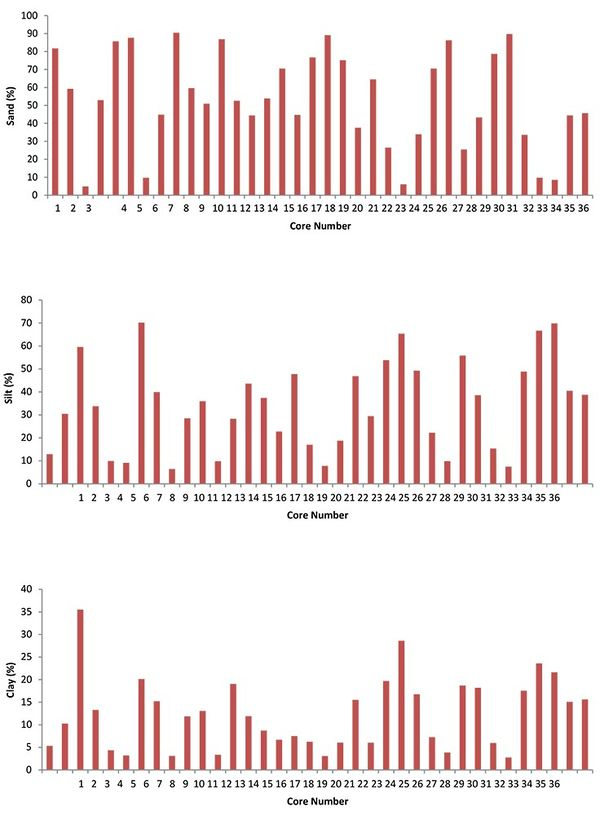
Organic matter
Loss on ignition varied between 3.18 and 12.06% in the homogenised cores taken from the six water bodies. Figure 13 shows that there was a general tendency for LOI to increase as distance from the head waters increased. This could be expected based on the assumption that because of slowing water currents the sediment may become slightly finer as more silt and clay settle, these being the particles that organic matter will preferentially bind to. However, the particle size distributions down the river channel previously described would suggest that no consistent fining of sediment particles was found downstream, and that particle size alone may not control organic matter concentration. This was confirmed by the lack of correlation between % clay and LOI (Figure 14a). Included in the clay size fraction will be a range of minerals such as (i) sub-micron oxides, (ii) sub-micron quartz and (iii) sub micron carbonate that do not contribute significant binding surfaces for organic matter. Rawlins (2011)[3] found that surface area was a better predictor than particle size for organic matter in sediments and this is largely controlled by the type and amount of clay minerals present. Further investigation by plotting organic matter against aluminium, a major component of clay, shows a positive correlation with organic matter (Figure 14b) suggesting that organic matter in the sediments is likely linked to clay content. A reasonable correlation is also found with titanium (Figure 14c) that is also a significant component of clay sized material.
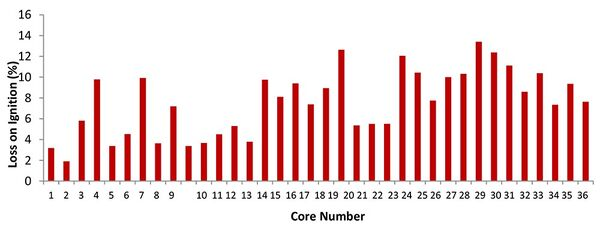

TP (TP) in homogenised sediment cores
TP (TP) was analysed in the homogenised sediment cores and results are shown in Figure 15. The source of TP can potentially be from numerous sources including (i) soil parent material (geological), (ii) fixation and occlusion of P in oxide minerals or the precipitation of P containing minerals where P is derived from agricultural fertilisers and (iii) similar processes as (ii) occurring in the river channel. It is evident that there was an increase in TP after core 18, the end of water body 3. This roughly coincides with the change of geology to the Whitby mudstone formation and suggests that from water body 4 onwards there may have been a different geological influence on TP concentrations in the eroding soil and river bed. We assessed TP along with particle size, organic matter and other major elements commonly associated with P minerals and sorption such as Ca, Mg, Fe and Mn. Initial correlation analysis suggested no strong relationships were present between TP and these parameters. Therefore, the TP dataset was divided into (i) water body 1–3 and (ii) water body 4–6 based on the TP results (Figure 15). Improved relationships (Figure 16) were found between TP and other elements (Fe & Mn), probably partly driven by the different soil parent materials found in different parts of the catchment. Van der Perk et al. (2007)[4] found both soil parent material and its chemical properties to be major factors in controlling catchment scale spatial variation in TP concentrations in sediments. Both Fe and Mn oxides are known to sorb P and eventually become occluded or precipitating with these oxide minerals, so the relationships whereby P and Fe/Mn are positively correlated is expected. These minerals could be iron phosphate or combined Mn/Fe phosphate minerals such as vivianite (Fe3(PO4)2·8H2O) for example. In particular, Mn appears to show a strong correlation with P in both water bodies 1–3 and 4–6. Kawashima et al. (1986)[5] found that phosphate is sorbed by MnOx via the presence of divalent cations (Ba2+, Ca2+, Sr2+, Mg2+) or transition metals (Mn2+, Co2+, Ni2+). For water body 4–6, a wide range of P concentrations were found sorbed to similar concentrations of Fe, possibly suggesting that the Fe oxides contained in the sediment have further capacity to sorb phosphate from the river waters. Many reports state that Phosphorus is often found associated with Ca in river sediments, probably as apatite which can precipitate as a mineral if water chemistry is suitable, but can also be found in the shells of aquatic molluscs. From these results it would appear that water bodies 1–3 have a positive correlation whilst in water bodies 4–6 there appeared to a slight negative correlation (Figure 16). It was obvious that mollusc shells were more plentiful in water bodies 1–3 and this may be the result why a positive correlation was observed.
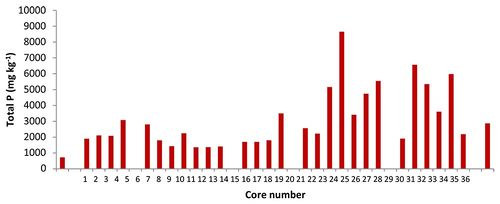
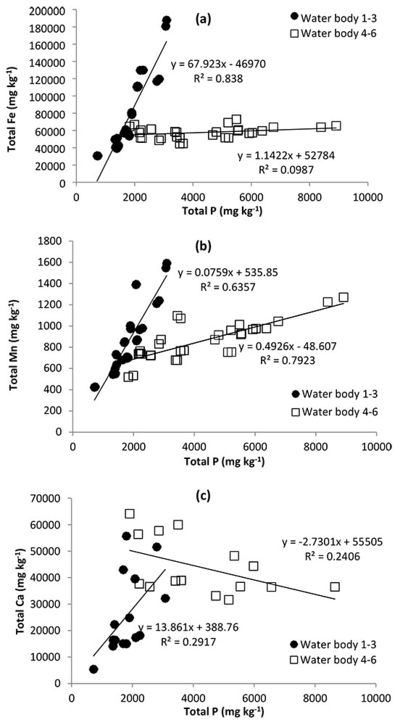
Extractable P in homogenised sediment cores
Concentrations of Olsen extractable P (OEP) for the 5 homogenised cores taken from each water body are shown in Figure 17 and mean values for each water body are shown in Figure 18. Results show a trend of increasing OEP concentrations from water body 1 through to water body 6. This is likely for three reasons. Firstly, the sediment distribution was slightly coarser in the headwaters, suggesting that clay and silt-sized particles that enter the channel are washed downstream by the faster flowing waters. The greater surface area provided by fine sediments will provide a greater sorption capacity for SRP from the river water. Secondly, greater deposition of sediment is found lower down the river as the cumulative catchment size increases, water currents are slower and catchment erosion rates generally increase (Table 15). Thirdly, the number of sources of SRP entering the river increase as the distance from the headwaters increase. This is demonstrated by the increase in SRP which appears to be associated with STW’s within the catchment (see River Nene water chemistry). Concentrations of OEP vary between ~17 -100 mg kg-1. There were no relationships between OEP and the typical sorption surfaces including LOI, Fe and Mn when analysing the whole dataset. However, splitting the data into water bodies 1–3 and 4–6 produced stronger linear regressions (Figure 19). No relationships were found in water bodies 1–3 between OEP and Fe, Mn and Ca. However, for water bodies 4–6, a positive linear regression with Mn and a weak negative linear regression with Ca were found. These results suggest that no specific sorption surface was dominant for OEP in water bodies 1–3, whereas in water bodies 4–6, Mn oxides appeared to assume a greater importance. It was found that OEP was <5% of TP in all instances with most samples being <2%. A positive correlation of rs = 0.72 was found between TP and OEP. However, there is no mechanistic basis for this relationship and it is likely that it is a consequence of more TP containing minerals being found as there is a gradual fining of sediment which also carries a greater sorption capacity.

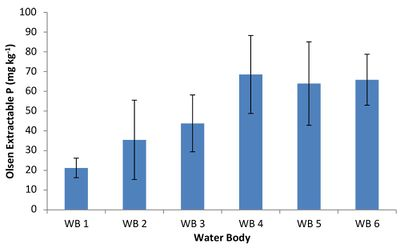
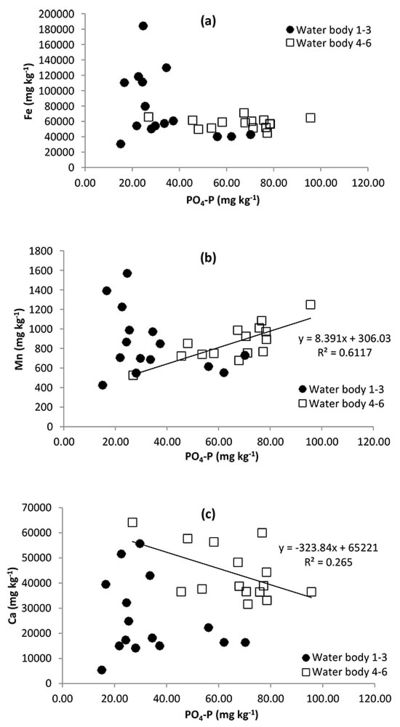
To place some context on the concentrations of OEP found in the sediments, it is possible to examine them compared to soil OEP values. This is generally undertaken by comparing soil Olsen P values on a 9 point scale based on mg P L-1 of soil (Table 5) produced by MAFF (2000)[6]. Litres are used because the roots of most agricultural crops were considered to grow in a litre of soil. Assuming soil bulk density is about 1.5g cm-3, the sediment OEP concentrations can be multiplied by ~0.66 to roughly fit this index. Therefore, sediment values from the Nene roughly coincide with Index categories 1–4, with most being in categories 3–4 in the later water bodies. It is suggested that no extra growth response is found in most crops above Index level 2 (MAFF, 2000[6]). Thus, it can be seen the sediment samples collected from the Nene contain relatively high levels of OEP compared to those required for agriculture, and that substantial OEP would be available for macrophyte growth in river sediments.
| Index Value | Olsen P (mg L‐1 Soil) |
| 0 | 0–9 |
| 1 | 10–15 |
| 2 | 16–25 |
| 3 | 26–45 |
| 4 | 46–70 |
| 5 | 71–100 |
| 6 | 101–140 |
| 7 | 141–200 |
| 8 | 201–280 |
| 9 | >280 |
Depth profiles of TP and OEP in sediment cores
CoreD from each of the six water bodies was used to examine the distribution of TP and PO4-P with depth (Figures 20 and 21). Concentrations of TP (Figure 20) in the sediment showed a wide range of concentrations up to ~5000 mg kg-1. Whilst individual cores demonstrated patterns of increase or decrease with depth, there was no systematic pattern across all the cores, suggesting that TP concentration with depth was a function of depositional environment, time and erosion. Similarly, Figure 21 shows the OEP concentrations with depth, with maximum concentrations being a little over 60 mg kg-1. There was little evidence of a systematic pattern of OEP deposition in any of the six water bodies. Concentrations of OEP were in a similar range to those from the homogenised cores. Results suggest that deposition, particle size, river flow speed and plant uptake are the major factors determining OEP concentration with depth.

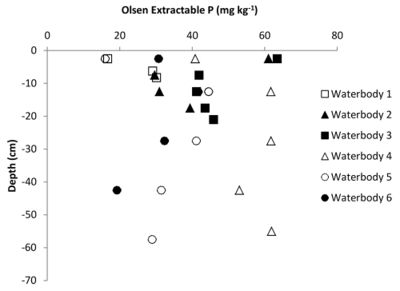
Determining the effective phosphorus concentrations (EPC0) in sediments
Using the top 5 cm taken from CoreD from each water body, the ‘Effective Phosphorus Concentration’ (see Calculation of effective phosphorus concentration) was determined. This figure represents the equilibrium concentration of phosphate in solution where desorption is equal to adsorption. This figure will likely be a function of the sediment properties such as particle size distribution, iron and aluminium oxide concentrations, organic matter as well as water properties such as electrical conductivity (as a proxy for ionic strength) and pH. Thus the results presented are indicative of the composition of sediment sampled and are broadly representative for the water body.
Figure 22 reports the isotherm and best fit lines for each of the six water bodies. In each case, the value of the EPC0 is determined where the isotherm crosses the X-axis. Comparison of the EPC0 concentrations of P with the SRP concentration determined in the water sample taken at each site (Table 6) shows that only in water body 1 does the EPC0 exceed the SRP in the water sample, thus suggesting that the sediment is a source of SRP. However, we believe that this is function of the high water flow causing dilution of SRP at the time of sampling, because the kinetic analysis (described in more detail in (see Calculation of rate constants for SRPsorption/desorption from sediments) did not indicate that desorption of SRP from this sediment occurred. For water bodies 1, 2 and 3 the EPC0 is below 1 µmol P L-1 whilst for water bodies 4, 5 and 6 the EPC0 is between 1 and 2 µmol P L-1. If the water SRP is greater than the EPC0 it is likely that the sediment has the capacity to adsorb SRP from the water column. If the water concentration of SRP is less than the EPC0 than desorption of phosphate may occur from the sediment to the water body.
Most studies from the UK suggest that most sediments have the potential for the adsorption of SRP (e.g. House & Denison, 1997[7]; House & Denison, 1998[8]). Jarvie et al. (2006)[9] reported that >80% of the river bed samples they tested had the potential for net SRP uptake from the water under stable low flow conditions. Potential for desorption may occur when water SRP concentrations fall below the EPC0 (Jarvie et al. 2006[9]). We can compare the EPC0 and SRP measurements using an ‘EPC0 percentage saturation’ term (EPC0sat) calculation, which describes the increase or decrease in SRP compared to the EPC0. This is defined as:
- EPC0Sat (%) = 100*(EPC0-SRP)/EPC0) Equation 15
Results from Table 6 suggest that there is considerable under saturation of the EPC0 suggesting that the sediment has considerable capacity to absorb more SRP before there is leakage back into the water at the measured concentration of SRP in the waters.
| Sample | F | k | RSS | EPC0 (µm P L‐1) | EPC0Sat (%) | kd L kg‐1 | SRP (µm P L‐1) |
| Water body 1 | 43.9 | 0.008 | 0.03 | 1.31 | 87.59 | 33 | 0.18 |
| Water body 2 | 52.2 | 0.029 | 0.44 | 0.61 | ‐180 | 249 | 1.65 |
| Water body 3 | 176 | 0.048 | 2.33 | 0.85 | ‐444 | 3743 | 4.63 |
| Water body 4 | 413 | 0.027 | 2.78 | 1.19 | ‐185 | 4286 | 3.40 |
| Water body 5 | 403 | 0.055 | 9.56 | 1.67 | ‐160 | 8445 | 4.35 |
| Water body 6 | 296 | 0.023 | 1.50 | 1.69 | ‐126 | 1555 | 3.83 |
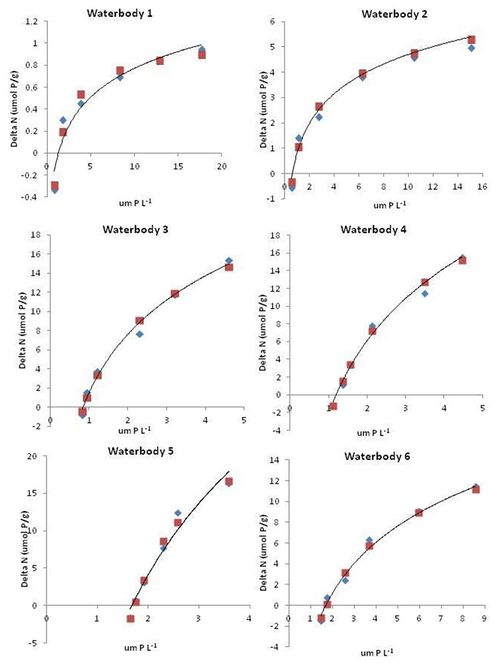
 ) and predicted (■) values with the modelled line of best fit based on equation 2 from which the Freundlich constants are derived.
) and predicted (■) values with the modelled line of best fit based on equation 2 from which the Freundlich constants are derived.Determining the rate of P uptake or desorption in sediments (Kinetics)
Rate constants were determined for the 0–5 cm segments of CoreD from each water body. As in the calculation of EPC0, values obtained are a function of the sediment composition sampled in terms of particle size, oxide content and pH. All sediments tested showed a rapid absorption of SRP (Figure 23), with a pseudo-equilibrium generally being reached within one hour. For water body 1 & 2, a 2µM P solution was used and for the other 4 water bodies a 4µM P equilibrating solution was used, these concentrations being slightly greater than those measured in the river waters at the time of collection. This rapid absorption is typical and has been found by other researchers (Jarvie et al. 2005[1]). However, in water bodies 3–6, a slight increase in SRP concentrations were found after about 6 hours. Although this was only a slight increase it appeared to be consistent. One possible explanation is that there is calcite present in the river sediment and its dissolution may have allowed PO4-ion exchange with HCO3-ions. However, it appeared not to strongly influence the kinetic coefficients determined (Table 7). These coefficients will be used in determining the take up of SRP from river water.

| Kr µmol l g h | Co | N | |
| Waterbody 1 Site 2 | 2.366 | 1.363 | 2.05 |
| Waterbody 2 Site 1 | 51.714 | 0.623 | 2.16 |
| Waterbody 3 Site 3 | 10.687 | 0.662 | 1.09 |
| Waterbody 4 Site 2 | 25.477 | 1.117 | 1 |
| Waterbody 5 Site 4 | 26.954 | 1.45 | 1.26 |
| Waterbody 6 Site 5 | 14.113 | 1.89 | 2.29 |
River Nene water chemistry
A water sample was collected and soluble reactive phosphorus (SRP) analysed at the same time as CoreD from each water body as part of the methodology to determine EPC0 and the kinetic rate constants. In addition, the complete hydrochemistry of this sample was analysed and is shown below (Table 8). Concentrations of TP and SRP were similar suggesting that most of the P in the <0.45 µm filtered sample was phosphate P. Different samples collected at the same sites as well as analytical error probably account for the fact that SRP is generally slightly greater than Total P determined by ICP-MS. The other element of particular note from this analysis is boron (B) whose background concentration is generally considered to be <30 µg L-1 (Jarvie et al., 2005[1]). The major source of boron in river waters is predominantly sewage effluent derived as it is used as a whitener in washing powders. Thus it is commonly used a tracer to assess whether PO4-P is sewage or agriculturally derived (Jarvie et al. 2006[9]; Neal et al. 2010[10]). In this study, despite the small number of sample points there was a positive correlation of r=0.80 (Figure 24) suggesting that the PO4-P in the river water was linked to discharges from STW’s. The increasing concentrations of PO4-P and B with increasing distance from the headwaters are likely a result of increasing numbers of STW’s feeding water into the river system. Figure 1 shows the STW’s that feed directly into the Nene or via tributaries. Jarvie et al. (2006)[9] report that typically SRP:B ratios in soil waters were between 36:1 and 53:1 for a range of arable and grassland soils, this being an order of magnitude higher than those found in river waters where the phosphate is derived from sewage treatment. In our samples we have PO4-P:B ratios of between 0.15:1 to 2:1. A ratio of 9.5 is considered a mean value for PO4-P:B for sewage effluent discharged without tertiary treatment (P treatment). The PO4-P:B ratios found in Table 8 are between 1 and 2.6 (excluding site 1). Jarvie et al. (2006)[9] suggest that when ratios are lower than 9.5, there are no major additional diffuse sources of SRP in relation to dominant point sources entering the water and that there may be losses of P to bed sediment or biota relative to B.
Table 8 Hydrochemistry of water (filtered <0.45 µm) samples collected at the same time as the collection of CoreD samples from the six water bodies of the River Nene. These samples are snapshots of the river at the time of sampling

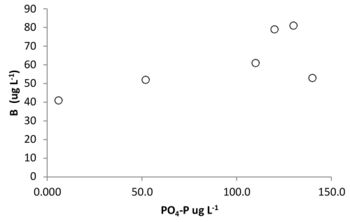
Sediment dynamics
The aims of work package 2 were associated with sediment, its volume, erosion, deposition and transport within the upper six water bodies of the river Nene. Understanding the sediment characteristics is essential to compiling the first-order estimates of TP and OEP masses and transport through the river system.
Probing sediment volumes and masses in water bodies
Estimates of contemporary volumes of sediment stored in the river channel were made by probing sediment at the time of sampling. Following on from sections Sediment distribution and depth in the River Nene and Use of probing data in calculations of P sediment volume, estimates of sediment volume were calculated and converted to masses using the Bulk Density (see Bulk density of sediment) calculated from the cores. Results can be found in Table 9.
| Water body | Sediment Volume (m3) | Sediment (kg) | Bulk Density (g cm‐3) |
| 1 | 584 | 291829 | 0.5 |
| 2 | 512 | 255755 | 0.5 |
| 3 | 851 | 425728 | 0.5 |
| 4 | 1381 | 690439 | 0.5 |
| 5 | 1654 | 826924 | 0.5 |
| 6 | 3911 | 1955294 | 0.5 |
Assessing sediment transport dynamics through water bodies using the CDP model
Sediment flux rates are presented for each water body catchment and for the whole catchment upstream of Peterborough from model predictions. Cumulative sediment discharge from each of these sub-catchments represents the total input of all upstream catchments through time. The percentage of these total sediment discharge rates transported as suspended sediment is also provided.
Two model runs
During the modelling phase of the study, there was an unforeseen interruption to the simulation, resulting in the 40 year modelling period being separated into two 20 year periods. Although the hydrology is re-initialised at steady state, the distribution of sediment uses the same initial homogeneous distribution, resulting in a spin-up requirement at the beginning of each period as the grain size distribution adjusts to hydrological conditions. The ‘spin-up’ is the period where the model is allowed to reach a ‘steady state’ and accounts for initial conditions that are not correct (i.e. no water in the system and heterogeneous sediment distribution). Sediment flux rates during the spin-up periods are not representative of the catchment and therefore are neglected in the assessment of the simulated results and in the projections forwards and backwards in time. The spin-up time, required for each period was 10 years, since beyond this, sediment flux rates are approximately linear when averaged over time. We use the average of the two model runs to estimate sediment transport in the intervening period.
Modelled sediment flux rates
The sediment flux rates for each of the sub-catchment outlets are given in Table 10 (1972–81) and Table 11 (1992–01). The total upstream sediment loss and annual flux rates includes sediment input from all upstream tributary catchments. The net volume change in sediment is equivalent to the change in volume for that particular water body stream reach (i.e. the amount of sediment entering the water body at its furthest upstream extent, minus the amount evacuated downstream to the next water body). The simulated annual average amount of sediment lost from the entire catchment is 864 m3 for the earlier simulation and 869 m3 for the later simulation.
Sediment flux in the upper sub-catchments (water bodies 1 and 2) is very low, averaging less than 26 m3 y-1. All of the water bodies show either a near even (± 5 m3 y-1) net volume change or net loss of sediment over the simulated periods, with the exception of water body 6. Modelling predicts that water body 6 is accumulating on average 587 m3 y-1 during 1972–81 and 1533 m3 y-1 during 1992–01. This is likely a result of changes in precipitation and ground water conditions leading to a higher sediment yield in the second period and reflects changes in the climate data.
| Water Body Outlet | Total Volume Loss (m3) 1972–81 |
Upstream Mean Annual Flux Rate (m3) 1972–81 |
Annual Net Volume Change (m3) 1972–81 |
| 1 | 11 | 1 | -1 |
| 2 | 0 | 0 | 1 |
| 3 | 1336 | 134 | -134 |
| 4 | 1313 | 131 | 3 |
| 5 | 14507 | 1451 | -1320 |
| 6 | 8638 | 864 | 587 |
| Water Body Outlet | Total Volume Loss (m3) 1992–01 |
Upstream Mean Annual Flux Rate (m3) 1992–01 |
Annual Net Volume Change (m3) 1992–01 |
| 1 | 11 | 1 | -1 |
| 2 | 258 | 26 | -25 |
| 3 | 227 | 23 | 3 |
| 4 | 1532 | 153 | -130 |
| 5 | 24016 | 2402 | -2248 |
| 6* | 8628 | 869 | 1533 |
* Rates for water body 6 are projected back to 1992, as steady state sediment transport was not
achieved in the model in this sub-catchment until 1995
Distributed sediment flux rates
The distributed net changes in sediment volume during the two modelling phases are presented in Figure 25 and Figure 26. In both cases the upper reaches of the catchment show less than 500 m3 change per model node over the 10 year period. The majority of net sediment changes occur in the lower reaches of the main river channel. The pattern of erosion and accumulation is similar in both scenarios and exhibits little change through time. Along the lower reaches of the river channel, sediment is eroded over long stretches and deposited at several intervals. Following the deposition of sediment, there is a down-river region of zero net volume change (i.e. no erosion or deposition). The reach where the most accretion occurs is water body 6, c.10 km from the end of the catchment, where over 44 000 m3 of material was deposited in a single node over the 10 year period 1972–82. The regions of greatest deposition occur in conjunction with a widening of the river channel in the Digital Elevation Model (DEM) and reduction in channel slope.
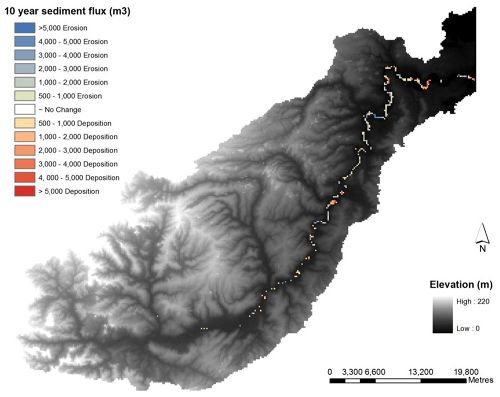
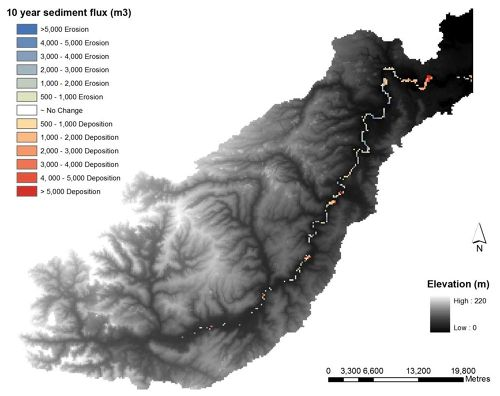
Cumulative twentieth Century sediment flux rates
The cumulative twentieth century sediment fluxes simulated by the model are presented in Figure 27. The two red lines in each of the water body plots represent the cumulative rate from the two modelled periods that have attained an approximately linear steady-state relationship. For the period prior to 1972, the mean flux rates from the 1972–1982 simulations were assumed appropriate and projected backward to assess sediment flux over 1910 to 1972. Similarly, beyond 2002, the mean flux rates from the 1992–2002 model run were used to project cumulative sediment flux forward to 2010. For the interim period 1982–1992, the average mean flux rates from the two simulated periods were used to predict sediment flux.
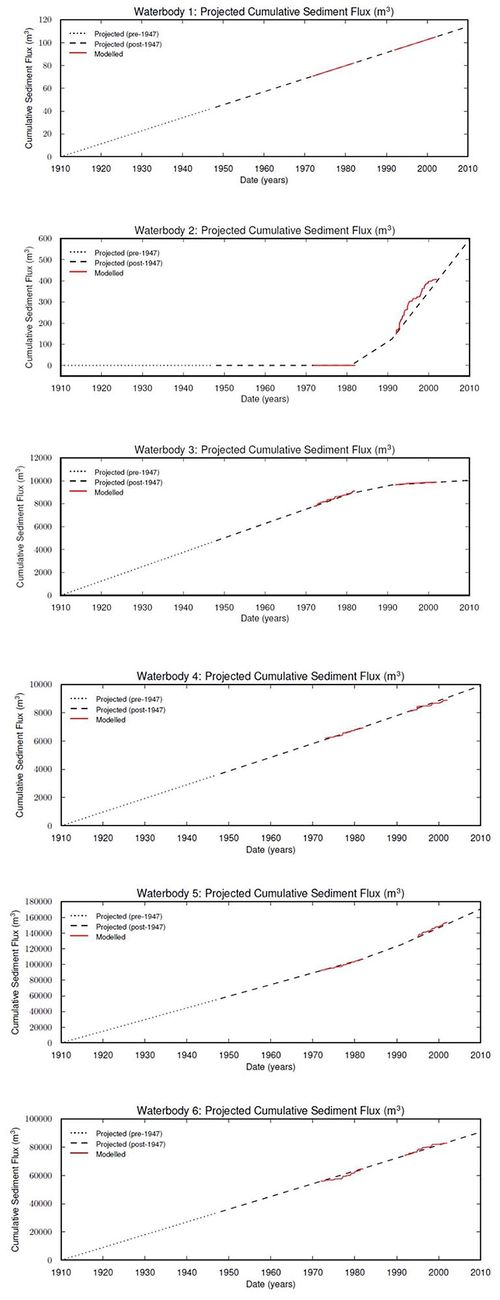
The cumulative flux rates are arbitrarily set to zero at 1910. The unknown influence of the 1947 snow melt floods on sediment erosion and deposition rates suggest greater uncertainty on the earlier sections of the plots (finer dashing). Water bodies in the upper reaches of the river (1, 2, and 3) show a varied response over the modelled periods. Water body one has a near perfect linear response, while water body 2 has differing responses when the two periods are compared, creating a non-linear overall appearance, with a more rapid rate of sediment loss observed in the 1992–2001 period of the simulation. Water body 3 has a tendency for sediment flux rates to tail-off towards the end of the simulation. The water bodies in the lower reaches of the river catchment (4, 5, and 6) exhibit a more uniform near-linear trend in sediment flux rates.
The percentage of sediment flux transported as bed load and suspended load is captured in Table 12. These proportions were determined by the simulation and were derived using a mean of the two steady-state modelling periods. However, for water body 1, these proportions could not be determined as there was insufficient flux of sediment leaving the water body during both modelling runs. For water body 2, bedload and suspended sediment percentages could only be determined from the second simulation period, again due to the low sediment flux in the first simulation. The water bodies with the highest proportion of suspended sediment are 2 and 4, with lowest being water body 5, which only averaged 8% suspended load over the steady-state simulation periods. This likely reflects greater bedload transport as a function of deeper flowing water in the model resulting in highest erosion rates (see Table 11 & Figure 26).
| Water Body Outlet | Percentage Bedload | Percentage Suspended |
| 1 | NA | NA |
| 2 | 80* | 20* |
| 3 | 85 | 15 |
| 4 | 79 | 21 |
| 5 | 92 | 8 |
| 6 | 86 | 14 |
* For the 2nd water body outlet the percentage could only be compiled from the later simulation
because there was zero volume change in the modelled first period
Catchment river discharge and sediment discharge events
To assess the relationship between river flows and sediment flux events, the two are plotted independently in Figure 28. Whilst some high flow events are accompanied by high sediment flux rates, particularly at the start of winter there are also high discharge events which result in little sediment transport. In Figure 29, modelled sediment transport from water bodies 6 and 3 are plotted directly against observed discharge at their two nearest gauging stations in the Nene Catchment (Orton and Upton respectively). Regression analysis reveals that there is no statistically significant relationship between catchment flow rates and sediment discharge events, preventing river gauging data from providing an alternative method to project modelled flux rates back through time.
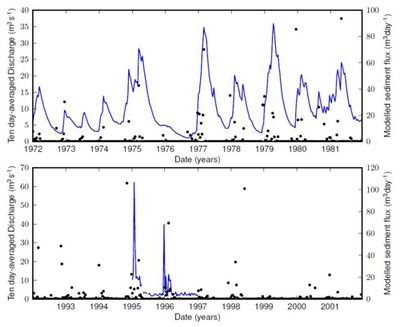
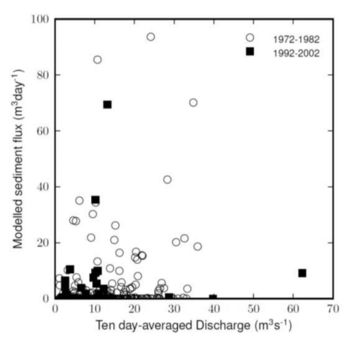
Analysis and discussion of CDP model results
The patterns of erosion and deposition are similar in both scenarios, suggesting catchment morphology is the dominant influence on the distribution of sediment transport in the Nene catchment. Water body 2 and 3 experienced markedly different rates of sediment flux between the two modelled periods. Water body 2 experienced more rapid rates in 1992–2002 than 1972–1982 whilst water body 3 saw a reduction in rates between the two periods (Figure 27). This is not a reflection of differing climate conditions but rather a reflection of the dynamic nature of sediment transport predicted by the CDP model.
The majority of erosion and deposition occurs along the main stem of the River Nene with deposition occurring in reaches where the channel gradient is lowest resulting in a wider channel and low modelled flow velocities. These reaches tend to coincide with areas that have been exploited for gravel extraction adjacent to the River Nene. In these locations the actual river course has often been fixed, however at the spatial resolution utilised for simulation this management of the water course cannot be taken into consideration. Hence, in the simulations the river naturally finds a course through these standing water bodies.
Water bodies 1 and 2 have the smallest relative catchment areas and therefore, may respond to small scale rainfall events not captured in the other water bodies. Also, due their elevation, they have low baseflow inputs from groundwater and the highest average precipitation values. These factors are likely to influence the sediment flux rates in these areas when compared to the other water bodies in the catchment and may explain why the sediment flux rates for water body 2 are inconsistent with the other areas.
Water body 6 has the largest suspended sediment transport volume and the most deposition. Both are attributable to the large bodies of standing water near Orton, where low channel gradient and low modelled flow velocities lead to deposition. The point of greatest deposition migrates down the river as sediment accumulates at the upstream end of this low gradient reach.
We were unable to find a direct relationship between modelled sediment flux and observed river gauging data for either of the gauging station sites, despite good agreement between gauging data and simulated water discharge. The lack of linear relationship represents both the distributed nature of the initialising and forcing datasets and the time lagging effects introduced by the groundwater component. This lack of a clear linear relationship prevented us using the gauging data to predict sediment flux rates for the periods where the model did not provide usable data (i.e. prior to 1972). Positive discharge excursions are not necessarily expected to link linearly to sediment discharge since there will be grain-size controlled thresholds in sediment transport such that a discharge event of a certain size will be required to achieve significant sediment transport for a particular grain-size fraction. Additionally, sediment transport will be dependent on sediment availability, such that when two events occur closely together there may be less sediment readily available for transport in the second event since a large amount of sediment has been transported in the first event. This phenomenon may explain why better agreement between gauging data and sediment flux was qualitatively observed for high flow events at the onset of winter.
The data extension pre-1947 has a large amount of associated uncertainty. It is likely that the 1947 flooding event flushed the channel system of sediment and this could be taken as a baseline from which sediment could be stored. It could also have placed sediment on the floodplains, where slack water reduced the ability to transport sediment. Although a relatively smaller event, the winter 2012 flooding in the Nene appeared to have scoured much of the sediment from the river bed (as noted in the 'Collection of sediments' section).
Several potential caveats are apparent in using the proposed modelling technique for derivation of sediment volumes. In modelling the hydrology that drives sediment transport we only have detailed observations for the past 50 years. Estimations of sediment transport for the past century will therefore have to be made by extrapolating erosional/depositional rate changes into the past. This assumes that current hydrology is analogous to the past. A detailed analysis of uncertainty in the second phase of modelling will be difficult to quantify without undertaking a suite of simulations. This was not possible given the timeframe or funding levels for this study.
Differences between water discharge and sediment flux rates are expected, due to the influence of groundwater and the complex interactions with surface hydrology on the spatial distribution of river flow.
A comparison of the CDP model and reported literature values of sediment yield in the Nene catchment
Catchment-averaged erosion rates (t km2 yr-1) were calculated from the CDP model output based on estimates of sediment leaving the catchment at the end of water body 6 (Table 13) assuming a sediment density of 1.3g cm3 to convert volume to mass. A search of the scientific literature found other estimates of erosion for the catchment of the river Nene and these are given in Table 13 for comparison. The literature values are mostly suspended sediment values, with those of Wilmot and Collins (1981)[11] being collected close to the Dog-in-Doublet lock, this being the end of water body 6. These values were converted to a catchment erosion rate (t km2 yr-1) of inorganic sediment, using the 34% organic matter value that Wilmot & Collins (1981)[11] cited.
| Study | Method | Total estimated sediment passing through water body 6 | Type of sediment | Organic matter % LOI From Wilmot & Collins 1981[11] | Corrected Total Sediment for LOI | Total upstream Catchment size | Erosion rate Inorganic |
| T yr‐1 | T yr‐1 | Km2 | T km2 yr‐1 | ||||
| CDP Model | Landscape evolution model | 676 | Inorganic | 1590 | 0.42 | ||
| Plater et al. 1994 | Uranium series dating | Inorganic | 2274 | 0.19 (summer) 0.91 (winter) | |||
| a Wilmot & Collins (1981)[11] | Suspended sediment | 19500 | Inorganic + organic | 34 | 12870 | 1590 | 8.09 |
| b Wilmot & Collins (1981)[11] | Total load based on depth integrated sampling restricted sections | 24000 | Inorganic + organic | 34 | 15840 | 1590 | 9.96 |
| c Wilmot & Collins (1981)[11] | Total load based on prediction of suspended sediment + 20% bed load | 16400 | Inorganic + organic | 34 | 10824 | 1590 | 6.81 |
| d Wilmot & Collins (1981)[11] | Overall Rating curve | 8400 | Inorganic | 8400 | 1590 | 5.28 |
Notes
a Suspended sediment determined based on a prediction equation relating catchment size to sediment load based on British Catchments.
b Depth integrated sampling at sluices to estimate ‘Total Load’. An average sediment concentration of 60 ppm derived from this sampling program was used and combined with monthly and annual mean daily water discharges to provide estimates of average annual loads.
c Short term suspended sediment data (bucket sampling) and mean daily discharges used to construct ratings curves between concentration and discharge. Annual suspended sediment loads were derived by combining the sediment concentration rating curves with the flow duration curve covering the same period. This was done by (i) dividing the discharge into 41 equally spaced logarithmic divisions, (ii) using the rating curve to predict sediment concentration corresponding to each discharge division and (iii) multiplying this concentration by the average discharge within the divison and the corresponding frequency of the occasion of flows.
d Analysis of longer term suspended sediment and water discharge data using annual, seasonal and overall rating curves. Reported annual suspended load values derived from an overall rating curve combined with a long term (overall) flow duration curve.
Comparison of the literature and the CDP modelled rates of catchment erosion (Table 13) measured in the River Nene provide a range of erosion rates. The CDP model and Uranium dating series estimates of Plater et al. (1994)[12] suggest erosion rates of <1 t km2 yr-1, these being an order of magnitude lower than the erosion rates calculated by the various different methodologies used by Wilmot and Collins (1981)[11] whose maximum catchment erosion rates were estimated at nearly 10 t km2 yr-1. The way in which rating curves are used can lead to significant over-estimation of the amount of sediment load (Walling, 1977[13]). Thus, Wilmot and Collins (1981) considered that estimates of erosion produced by using methods (c) and (d) (see Table 13 footnotes) of ~5–6 t km2 yr-1 were the most reliable. The suspended sediment yields reported for the river Nene in Table 13 are generally quite low compared to the median suspended sediment in UK rivers of ~50 t km2 yr-1 (Walling & Webb, 1987[14]). Wilmot and Collins (1981)[11] suggest that sediment concentration in the rivers of the Wash basin (Nene, Welland, Great Ouse) is controlled by sediment availability rather than the transporting capacity of the rivers, this being a result of the wide, flat catchments, typical of the Nene.
We consider that the differences in the catchment erosion rates (Table 13) are largely a function of anthropogenic influences in the catchment which are included in the higher estimated rates of Wilmot & Collins (1981)[11]. Estimates provided by the CDP model are natural erosion rates based on landscape evolution and as such do not include anthropogenic factors such as under-land drainage and urban runoff. Similarly, the measurements based on uranium dating are described as being based on a time scale commensurate with the half-lives of 230Th and 234U, providing estimates of sediment yield integrated over the late Quaternary (Plater et al. 1988[15]). Thus, both these methods provide a baseline or ‘steady-state’ estimate of erosion. However, the results published by Wilmot and Collins (1981)[11] are suspended sediment concentrations and represent a snapshot of catchment erosion rates during sampling, and will include anthropogenic influences that affect erosion and transport to the river system such as land drainage and urban development.
It is unknown to what extent the Catchment Sensitive Farming Initiative (Collins et al. 2007[16]) in the Nene Catchment that runs until 2014 has reduced soil erosion with associated P input into the river but most arable fields bordering the river in the study area appeared to have buffer strips. However, it is evident that within the Nene catchment, where the soils are poorly draining, a significant proportion of contemporary catchment erosion is anthropogenically influenced with soil erosion to the river via land drains a major contributor (Worsfold, 2006[17]). For example, Foster et al. (2003)[18] suggested that >50% of the total catchment suspended sediment yield over a 2 year period originated from land drains in the Rosemaud experimental catchment in Herefordshire. In their study, annual erosion from just one land drain amounted to 964 and 978 kg ha-1 yr-1. With the inclusion of buffer strips along most arable fields as an aid to nutrient filtering and soil erosion management to protect river waters, the land drainage pathway is probably of greater importance.
In the current study it is evident that anthropogenic influences increase the catchment erosion by approximately 10–12 times from 0.5 t km2 yr-1 to 5–6 t km2 yr-1. The difference in erosion process (natural erosion or largely anthropogenically mediated events), also produces a difference in the bed load:suspended sediment ratio in the river channel. The CDP model calculates that without anthropogenic mediation, between 80–90% of sediment is moved as bed load (Table 5) (though the use of a single grain-size distribution in model initiation may influence these values). However, Wilmot & Collins (1981)[11] suggest that the influence of land drains, urban areas and sewage works results in suspended sediment and bed load making up 80 and 20% of the total sediment yield respectively. In the next section these ratios are used to calculate channel transport of sediment based on CDP model outputs and literature catchment erosion rates.
Obtaining first order estimations of catchment erosion and sediment transport
When compared to literature results the CDP model predictions were found to be order of magnitude lower than published values as a result of the CDP model not being able to account for more anthropogenically mediated erosion processes. Thus, we scale the modelled sediment discharges for the entire catchment, and for each water body, to approximate anthropogenic sediment inputs in the simulated data.
The modern value of catchment suspended sediment discharged from water body 6 was obtained from the combined rating curve estimate of 8400 t yr-1 as defined by Wilmot & Collins (1981)[11]. Using the catchment area (1590 km2), the catchment averaged erosion rate is 5.28 t km2 yr-1. Wilmot & Collins (1981)[11] cite a ratio of 80:20 suspended sediment to bed load. To take into account the bed load the total catchment sediment discharge is increased according to this ratio (6.6 t km2 yr-1 or 10 500 t yr-1). For direct comparison of the catchment sediment discharge, the average model simulated discharge (866.5 m3 yr-1) is converted into an average sediment discharge rate (1126 t yr-1) using a sediment density of 1.3g cm-3. This rate can be divided into bed load and suspended load discharge rates based on the water body 6 ratio defined in Table 12. The total catchment sediment discharge scaling ratio (Table 14), which we use to approximate the anthropogenic influence on the simulated naturalised rates for each water body, is derived as the ratio of simulated to published sediment discharge values.
To calculate the additional influence of anthropogenic sediment fluxes on the modelled results, the sediment discharge scaling ratio is applied to the simulated sediment discharge rates for each water body for each period 1972–81 (Table 15) and 1992–01 (Table 16). To maintain uniformity with published results, we also convert the calculated sediment discharge rates into water body erosion rates based on the water body area. These values were used to calculate phosphorus and phosphate transport through the river body (See Masses of sediment associated TP and OEP moving between water bodies — CDP & Wilmot & Collins (1981)).
| Sediment passing WB6 (T yr‐1) |
Bedload (T yr‐1) |
Suspended Load (T yr‐1) | |
| Model | 1126 | 969 | 158 |
| Wilmot & Collins, 1981[11] | 10500 | 2100 | 8400 |
| Scaling Ratio | 0.46 | 0.019 | |
| CDP model: Wilmot & Collins 1981[11] |
A comparison of results between the naturalised (or baseline) CDP model predictions and those assuming a greater anthropogenic influence are shown in Table 15 and 16 and Figures 30 and 31. These results are likely to give the range of first order approximation of sediment movement between water bodies for the River Nene under typical annual weather scenarios. It is considered unlikely that they will provide accurate data for extreme years such as 1947 or 2012.
Table 15 Comparison of CDP model (background) v anthropogenically mediated (Wilmot & Collins, 1981[11]) estimates of bedload and suspended sediment leaving each waterbody for the six water bodies of the River Nene based on model parameters produced for the period 1972–1981

Table 16 Comparison of CDP Model v literature (Wilmot & Collins, 1981[11]) estimates of bed load and suspended sediment leaving each water body for the six water bodies of the River Nene based on model parameters produced for the period 1992–2001

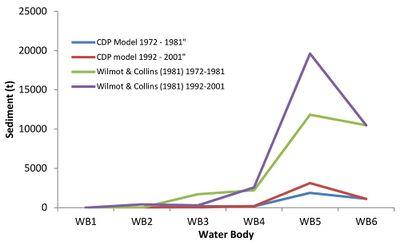

Calculating P loads in the sediments and waters of the River Nene
Masses of Phosphorous and extractable phosphate in river sediment
Probed sediment volumes, sediment bulk density (Db), TP and OEP results were combined to determine first order estimates of the quantities of P in the sediments of each of the six water bodies (Table 17). Estimates of sediment volume were based on the river channel conditions outlined in Table 4.
| Water body | Sediment Vol (M3) |
Sediment (kg) | Bulk Density (g cm-3) |
Mean TP (mg kg‐1) |
TP (Tonnes) | Mean PO4-P (mg kg‐1) | PO4-P (Tonnes) |
| 1 | 584 | 291829 | 0.5 | 1978 | 577 | 21.22 | 6.19 |
| 2 | 512 | 255755 | 0.5 | 1927 | 493 | 35.45 | 9.07 |
| 3 | 851 | 425728 | 0.5 | 1597 | 680 | 43.78 | 18.64 |
| 4 | 1381 | 690439 | 0.5 | 4420 | 3052 | 68.55 | 47.33 |
| 5 | 1654 | 826924 | 0.5 | 4433 | 3666 | 63.94 | 52.87 |
| 6 | 3911 | 1955294 | 0.5 | 3997 | 7815 | 65.85 | 128.76 |
Masses of sediment associated TP and OEP moving between water bodies - CDP & Wilmot
& Collins (1981)[11]
Based on the two scenarios discussed in the Obtaining first order estimations of catchment erosion and sediment transport section and shown in Tables 15 & 16 the movement of sediment associated TP and OEP is estimated between the different water bodies. These were calculated by combining sediment movement with concentrations of sediment TP and OEP (Tables 18–21). As would be expected the amount of sediment associated P that moves between water bodies will be largely a function of total sediment transport and concentration (Figure 32). For both TP and OEP, export of P from water bodies is reasonably low as sediment movement (Tables 15 & 16) is low. After water body 4 erosion input and transport of sediment increases, thus increasing the movement of TP and OEP (Tables 15 & 16).
CDP |
Literature value = 6.60 t km2 yr-1 | |||||||
| Water body | Sediment volume leaving water body (M3) | Sediment leaving water body (t) | Mean TP (mg kg-1) | TP lost from water body (kg) | Sediment volume leaving water body (M3) | Sediment leaving water body (t) | Mean TP (mg kg-1) | TP lost from water body (kg) |
| 1 | 1 | 1.3 | 1978 | 2.57 | - | 0.286 | 1978 | 0.57 |
| 2 | 0 | 0 | 1927 | 0 | - | 0 | 1927 | 0.00 |
| 3 | 134 | 173.7 | 1597 | 277 | - | 1712 | 1597 | 2734 |
| 4 | 131 | 170.7 | 4420 | 754 | - | 2207 | 4420 | 9755 |
| 5 | 1451 | 1885 | 4433 | 8360 | - | 11827 | 4433 | 52431 |
| 6 | 864 | 1122 | 3997 | 4487 | - | 10494 | 3997 | 41944 |
Model |
Literature value = 6.60 t km2 yr-1 | |||||||
| Water body | Sediment volume leaving water body (M3) | Sediment leaving water body (t) | Mean OEP (mg kg-1) | OEP lost from water body (kg) | Sediment volume leaving water body (M3) | Sediment leaving water body (t) | Mean OEP (mg kg-1) | OEP lost from water body (kg) |
| 1 | 1 | 1.3 | 21.2 | 0.03 | - | 0.286 | 21.2 | 0.01 |
| 2 | 0 | 0 | 35.4 | 0 | - | 0 | 35.4 | 0.00 |
| 3 | 134 | 173 | 43.7 | 7.59 | - | 1712 | 43.7 | 74.8 |
| 4 | 131 | 170 | 68.5 | 11.69 | - | 2207 | 68.5 | 151 |
| 5 | 1451 | 1885 | 63.8 | 120.3 | - | 11827 | 63.8 | 754 |
| 6 | 864 | 1122 | 65.8 | 73.89 | - | 10494 | 65.8 | 690 |
| Total | ||||||||
Model |
Literature value = 6.60 t km2 yr-1 | |||||||
| Water body | Sediment volume leaving water body (M3) | Sediment leaving water body (t) | Mean TP (mg kg-1) | TP lost from water body (kg) | Sediment volume leaving water body (M3) | Sediment leaving water body (t) | Mean TP (mg kg-1) | TP lost from water body (kg) |
| 1 | 1 | 1.3 | 1978 | 2.57 | - | 0 | 1978 | 0 |
| 2 | 26 | 33.8 | 1927 | 65.1 | - | 417 | 1927 | 803 |
| 3 | 23 | 29.9 | 1597 | 47.7 | - | 291 | 1597 | 465 |
| 4 | 153 | 199 | 4420 | 879 | - | 2578 | 4420 | 11396 |
| 5 | 2402 | 3122 | 4433 | 13842 | - | 19602 | 4433 | 86898 |
| 6 | 869 | 1130 | 3997 | 4516 | - | 10494 | 3997 | 41944 |
| Total | ||||||||
Model |
Literature value = 6.60 t km2 yr-1 | |||||||
| Water body | Sediment volume leaving water body (M3) | Sediment leaving water body (t) | Mean OEP (mg kg-1) | OEP lost from water body (kg) | Sediment volume leaving water body (M3) | Sediment leaving water body (t) | Mean OEP (mg kg-1) | OEP lost from water body (kg) |
| 1 | 1 | 1. 3 | 21.2 | 0.03 | - | 0 | 21.2 | 0.00 |
| 2 | 26 | 33.8 | 35.4 | 1.19 | - | 417 | 35.4 | 14.7 |
| 3 | 23 | 29.9 | 43.7 | 1.31 | - | 291 | 43.7 | 12.7 |
| 4 | 153 | 199 | 68.5 | 13.64 | - | 2578 | 68.5 | 176 |
| 5 | 2402 | 3122 | 63.8 | 199.2 | - | 19602 | 63.8 | 1250 |
| 6 | 869 | 1129 | 65.8 | 74.3 | - | 10494 | 65.8 | 690 |
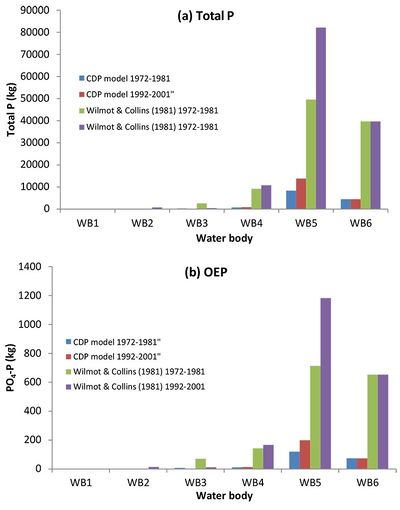
Uptake of SRP from river water in each water body
By combining results from the kinetic experiments (see Determining the rate of P uptake or desorption in sediments (Kinetics)) with river speed (m s-1) we can determine first order estimates of the quantity of SRP that is potentially absorbed by the sediment. Calculations were based on an active sediment layer (0–5 cm), corresponding to the 0–5 cm fraction analysed and a water depth of 10 cm above the sediment. Sediment volumes from the probing analysis were used to provide the amount of sediment that would interact with it (Table 4) and these values were used in calculating Tres (Equations 4 & 5). Water speed in River Bodies 1, 2 and 3 were measured whilst we use mean flow (9.3 cumecs) data obtained from Orton, converting from cumecs to m sec-1 for use in equation 4 & 5 for Water Bodies 4–6. This gave water speeds of ~1100 m hr-1 for the headwaters and for Water Bodies 4–6 a mean value 440 m hr-1 was used.
Table 22 reports the characteristics used in equations 4 & 5 to determine the quantity of SRP sorbed by the sediment per km of water body. In Table 23 we report this figure as a percentage of the total SRP that was found in the water at the time of sampling. Results suggest that potentially the highest SRP sorption occurred in water body 5 where up to 40g P could be sorbed per km. This amounts to about 10% of the SRP that is contained in the water in the 10 cm layer that interacts with the 5 cm of sediment.
| Waterbody | Kr | n | Ct | EPC0 | S (g) | µmol P | g P | Tres | g P Sorbed |
| Waterbody 1 | 2.36 | 2.05 | 0.18 | 1.36 | 93000000 | NC | NC | 0.11 | NC |
| Waterbody 2 | 51.7 | 2.16 | 1.65 | 0.62 | 183000000 | 10024238223 | 310490 | 0.21 | 0.045 |
| Waterbody 3 | 10.6 | 1.09 | 4.63 | 0.66 | 180000000 | 8641147685 | 267650 | 2.63 | 6.89 |
| Waterbody 4 | 25.4 | 1 | 3.4 | 1.12 | 180000000 | 10469518380 | 324282 | 5.45 | 29.7 |
| Waterbody 5 | 26.9 | 1.26 | 4.35 | 1.45 | 180000000 | 18557403313 | 574797 | 6.36 | 40.5 |
| Waterbody 6 | 14.1 | 2.29 | 3.83 | 1.89 | 180000000 | 11586647861 | 358884 | 4.55 | 20.7 |
NC = Not calculated because of dilution of the measured PO4-P concentration meant it was below EPC0.
Sediment however was an absorbing sediment and not a desorbing one.
| Width of channel | Depth of channel | length channel | volume of water | L of water | µmol P L‐1 | µmol P in channel | g P in channel water | g P sorbed | % | |
| Waterbody 1 | 1.55 | 0.1 | 1000 | 155 | 155000 | 0.18 | 27900 | 0.86 | - | - |
| Waterbody 2 | 3.05 | 0.1 | 1000 | 305 | 305000 | 1.65 | 503250 | 15.58 | 0.044 | 0.28 |
| Waterbody 3 | 11.55 | 0.1 | 1000 | 1155 | 1155000 | 4.63 | 5347650 | 165.63 | 6.89 | 4.16 |
| Waterbody 4 | 24 | 0.1 | 1000 | 2400 | 2400000 | 3.4 | 8160000 | 252.74 | 29.75 | 11.77 |
| Waterbody 5 | 28 | 0.1 | 1000 | 2800 | 2800000 | 4.35 | 12180000 | 377.26 | 40.49 | 10.73 |
| Waterbody 6 | 20 | 0.1 | 1000 | 2000 | 2000000 | 3.83 | 7660000 | 237.26 | 20.66 | 8.70 |
References
- ↑ 1.0 1.1 1.2 Jarvie, H P, Jürgens, M D, Williams, R J, Neal, C, Davies, J J L, Barrett, C, and White, J. 2005. Role of river bed sediments as sources and sinks of phosphorus across two major eutrophic UK river basins: the Hampshire Avon and Herefordshire Wye. Journal of Hydrology, 304, 51–74.
- ↑ Fisher, S G, Sponsellar, R A, and Heffernan, J B. 2004. Horizons in stream biogeochemistry: Flowpaths to progress. Ecology, 85(9), 2369–2379.
- ↑ Rawlins, B G. 2011. Controls on the phosphorus content of fine stream bed sediments in agricultural headwater catchments at the loandscape-scale. Agriculture, Ecosystems and Environment, 144, 352–363.
- ↑ Van der Perk, M, Owens, P N, Deeks, L K, Rawlins, B G, Haygarth, P M, and Bevan, K J. 2007. Controls on catchment-scale patterns of Phosphorus in soil, streambed sediment and stream water. Journal of Environmental Quality, 36, 694–708.
- ↑ Kawashima, M, Tainaka, Y, Hori, T, Koyama, M, and Takamatsu, T. 1986. Phosphate adsorption onto hydrous manganese (IV) oxide in the presence of divalent cations. Water Research, 20(4), 471–475.
- ↑ 6.0 6.1 6.2 MAFF. 2000. Fertiliser recommendations for agricultural and horticultural crops (RB209). The Stationary Office, London, UK.
- ↑ House, W A, and Denison, F H. 1997. Nutrient dynamics in a lowland stream impacted by sewage effluent: Great Ouse, England. Science of the Total Environment, 205, 25–49.
- ↑ House, W A, and Denison, F H. 1998. Phosphorus dynamics in a lowland river. Water Research, 32(6), 1819–1830.
- ↑ 9.0 9.1 9.2 9.3 9.4 Jarvie, H P, Neal, C, and Withers, P J A. 2006. Sewage-effluent phosphorus: a greater risk to river eutrophication than agricultural phosphorus? Science of the Total Environment, 360, 246–253.
- ↑ Neal, C, Jarvie, H P, Withers, P J A, Whitton, B A, and Neal, M. 2010. The strategic significance of wastewater sources to pollutant phosphorus levels in English rivers and to environmental management for rural, agricultural and urban catchments. Science of the Total Environment, 408, 1485–1500.
- ↑ 11.00 11.01 11.02 11.03 11.04 11.05 11.06 11.07 11.08 11.09 11.10 11.11 11.12 11.13 11.14 11.15 11.16 11.17 11.18 11.19 11.20 11.21 11.22 11.23 11.24 Wilmot, R D, and Collins, M B. 1981. Contemporary fluvial sediment supply to the Wash. Special Publication International Association of Sedimentologists, 5, 99–110.
- ↑ Plater, A J, Dugdale, R E, and Ivanovich, M. 1994. Sediment yield determination using uranium-series radionuclides: the case of The Wash and Fenland drainage, eastern England. Geomorphology, 11, 41–56.
- ↑ Walling, D E. 1977. Limitations of the rating curve technique for estimating suspended sediment loads, with particular reference to British rivers: Erosion and solid matter transport in inland waters. IAHS Publication, Wallingford, 122, 34–48.
- ↑ Walling, D E, and Webb, B W. 1987. Suspended load in gravel-bed rivers: UK experience. In: Thorne, C R, Bathurst, J C, and Hey, R D. eds. Sediment transport in gravel-bed rivers, 691–723. Chichester: Wiley.
- ↑ Plater, A J, Dugdale, R E, and Ivanovich, M. 1988. The application of Uranium series Disequilibrium concepts to sediment yield determinations. Earth Surface Processes and Landforms, 13, 171–182.
- ↑ Collins, A L, Strömqvist, J, Davison, P S, and Lord, E I. 2007. Appraisal of phosphorus and sediment transfer in three pilot areas indentified for the catchment sensitive farming initiative in England: application of the protype PSYCHIC mode. Soil Use and Management, 23(S1), 117–132.
- ↑ Worsfold, P. 2006. Processes affecting transfer of sediment and colloids, with associated phosphorus, from intensively farmed grasslands: an overview of key issues, Hydrological Processes, 20, 4407–4413.
- ↑ Foster, I D L, Chapman, A S, Hodgkinson, R M, Jones, A R, Lees, J A, Turner, S E, Scott, M. 2003. Changing suspended sediment and particulate phosphorus loads and pathways in underdrained lowland agricultural catchments; Herefordshiore and Worcestershire, U.K. Hydrobiologia, 494, 119–126.